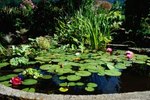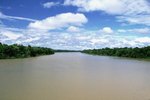
Dojo loaches are known as weather loaches because they get active when the barometric pressure changes. The fish are usually relatively inactive during the day, so when they come alive, the change is noticeable. A change in dojo loach behavior indicates a change in barometric pressure, often the precursor to storms. The species' behavior tips of fish hobbyists about upcoming weather.
Aquarium Setup
Dojo loaches (Misgurnus anguillicaudatus) have some specialized aquarium requirements. Loaches in general and this species in particular likes to hang out on the bottom of the aquarium. Additionally, they like to bury themselves when they sleep during the day, so they should have soft substrate like sand instead of aquarium gravel. They need hiding places to help them feel safe, so aquarium decorations like rocks and driftwood are a must. You will also need cover filter inlets, since this species has a tendency to explore and get stuck in filters.
Water Conditions
In general, dojo loaches are not super-particular about their water chemistry. They can live in water with pH between 6.0 and 8.0. They require cooler water than most aquarium fish, though; they prefer water between 64 and 74 degrees Fahrenheit, while most aquarium fish prefer warmer water. They need lots of water movement to ensure their water is well-oxygenated.
Tankmates
Dojo loaches get along best with fish who prefer to swim in the upper levels of the the tank, since the loaches don't have to share their territory. Since these loaches prefer cooler temperatures, they can share a tank with goldfish. However, they should share a tank only with comets and other fast-moving goldfish. Fancy varieties of goldfish with long fins can have trouble keeping up with these loaches at feeding time. Avoid aggressive fish that will pick on loaches and fish that prefer tropical conditions.
Diet
Dojo loaches will eat flake food, but sinking pellets work better, since they ensure that the loaches get enough to eat. In the wild, they mostly forage on river bottoms for insect larvae and crustaceans. In light of this, you can occasional add live and frozen foods like brine shrimp and bloodworms. You can find these at most pet shops. Variety promotes health by broadening your fishes' nutrient base, so do your best to mix it up.
References
Photo Credits
-
Hemera Technologies/AbleStock.com/Getty Images




